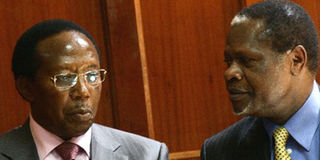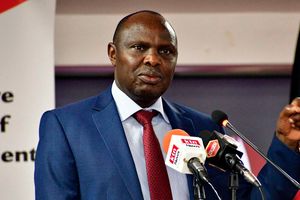Okemo, Gichuru cost taxpayers billions in loan repayments

Former Kenya Power and Lighting Company (KPLC) managing director Samwel Gichugu and former Energy minister Chris Okemo during a mention of an extradition case against them. The two are charged with money laundering. PHOTO | BILLY MUTAI | NATION MEDIA GROUP
What you need to know:
- On Thursday, Mr Gichuru maintained a studious silence on his pending extradition to Jersey, where he is expected to stand trial for money laundering.
- However, a Jersey court has already seized over Sh520 million, which was hidden there by both Mr Okemo and Mr Gichuru.
- In total, there were six companies set up to launder payments made by various contractors of KPLC to benefit Mr Gichuru, Mr Okemo and others.
Kenyans have been repaying a Sh8.2 billion loan that KPLC took out 26 years ago to fund a non-existent Ewaso Nyiro hydropower plant.
Part of the loan, borrowed in 1990, was diverted to Mr Samuel Gichuru’s bank account in Jersey Island.
At the time, Mr Gichuru was the managing director of the Kenya Power and Lighting Company (KPLC).
Taxpayers will continue repaying the loan for the next four years, yet not even one kilowatt of electricity was generated by the Ewaso Nyiro plant.
On Thursday, Mr Gichuru maintained a studious silence on his pending extradition to Jersey, where he is expected to stand trial for money laundering.
Jersey is a tax haven island between England and France. “I will call you back,” Mr Gichuru said when contacted by the Daily Nation.
Details of how both he and former Finance Minister Chris Okemo hid the money they diverted from phantom power projects have now emerged, revealing an intricate web of foreign companies that openly paid bribes, deposited into the two officials’ Jersey accounts.
Both have gone to court in Nairobi seeking to stop their extradition. The case is yet to be concluded.
However, a Jersey court has already seized over Sh520 million, which was hidden there by both Mr Okemo and Mr Gichuru.
Jersey initiated investigations against the two after the matter of the Ewaso Nyiro dam was raised in the House of Commons in January 2001.
This was one of three dams that were expected to cost $350 million (Sh35 billion at today’s exchange rate). The three dams were to be completed by 2007.
(Read: Gichuru and Okemo lose Sh520 million stashed in Jersey Island)
The contract for the initial feasibility study was awarded to a British company, Knight Piesold.
THE GENESIS
However, questions were raised when it emerged that the cost was “five times what such services would normally cost”, according to a World Bank report published in 1992.
When this anomaly was pointed out, Mr Gichuru and Knight Piesold representatives worked together to create backdated correspondence to ease payments.
To facilitate bribes to Mr Gichuru’s firm, Windward Trading Company, Knight Piesold was first paid $15.3 million (Sh1.5 billion), although the project for which the money was meant had not even started.
Knight Piesold published 14 reports between 1991 and 1993. Each report cost an average of $2.7 million (Sh270 million). That means the feasibility study alone cost Kenyan taxpayers Sh3.8 billion.
Interestingly, the project was covered by the British Government through its Export Credits Guarantee Department (ECGD), which supports UK companies to seek and win tenders abroad.
The ECGD has over the years been accused by Transparency International and other lobby groups of turning a blind eye to bribe-paying British companies and providing a cover to their operations in developing countries.
The ECGD’s mandate is to ensure that the loans are repaid even if the projects it covers collapse. At one point, it was christened “the department of dodgy deals”.
On June 21, 1990, the ECGD supported a £68.1 million loan (Sh8.2 billion) between ANZ Grindlays Bank and the Moi administration.
The money was to finance the contract between KPLC and Knight Piesold.
It was this money that would later be stolen and diverted to Jersey Island, where Mr Gichuru had opened secret bank accounts in 1986 with the help of Deloitte & Touche, a Jersey accounting firm.
Later, under pressure from the House of Commons, Knight Piesold officials turned against Mr Gichuru, revealing the fraud that took place at KPLC at taxpayer expense.
“It was impossible to do work in Kenya without paying commission to important political figures,” said Mr Peter Garrat, an official with Knight Piesold in court papers.
“It was like a tax. Knight Piesold paid such commissions to various people. Without doing so, we would never have been able to work there. One person we paid was Samuel (Gichuru).”
BRIBERY KNOWLEDGE
The scheme was simple.
KPLC would identify the project to be funded. It would then approach a UK bank. The ECGD would then provide a guarantee to the bank that the loan would be repaid in full no matter what.
The bank would then use the loan to pay the contracted UK company for goods and services received.
However, Mr Gichuru would inflate the bills and the UK company — in this case Knight Piesold — would forward the balance to his Jersey accounts.
Court records indicate that even though Mr Gichuru was the KPLC managing director, he disguised himself as a broker and consultant.
Mr Mike Durham, one of the managing directors of Mort MacDonald, which paid hefty kickbacks, told the court that he knew they were paying bribes to Mr Gichuru.
“I knew that Mort MacDonald had arrangements to look after Gichuru. He was not an agent in the proper sense of the word. He was our client ... and he was good to us,” he said.
“The only purpose of these payments was to help Gichuru to give us contracts and help us have a good relationship with him”.
On different dates between 1986 and 2002, Windward received payments worth $5.4 million (Sh540 million), £5.3 million (Sh636 million), £4.4 million (Sh528 million), $3.3 million (Sh330 million) and 6.8 million Danish kroners (Sh102 million) from various companies contracted by KPLC. That was just over Sh2 billion.
Court records show that Mr Gichuru used part of the Sh2.1 billion for his “personal expenditure” while Mr Okemo invested his share with “recognised financial institutions”.
After he realised that the British authorities were after him, Mr Gichuru attempted to hide some of the cash in a Gibraltar-based company, Arus Management Services.
MONEY LAUNDERING
For instance, on May 18, 2001, Windward wired $150,030 to Arus. Arus was one of the many companies set up to launder the bribes.
Knight Piesold usually sent its bribes to a Jersey company identified as Camargo Ltd. Another KPLC contractor, Union Fenosa, would send its bribes via a Luxembourg company, Ashdene Group Ltd.
Another contractor, Motorola Communications of Israel, used a Jersey company, Coburg Investments Ltd.
In total, there were six companies set up to launder payments made by various contractors of KPLC to benefit Mr Gichuru, Mr Okemo and others.
“The reason such expensive steps were taken to launder this money is that it arose from criminal conduct… Okemo and Gichuru were public officers. Their acceptance of bribes constituted misconduct in a public office,” say the extradition papers.
The kickbacks were usually put at eight per cent as confirmed in a 1986 memorandum by Mike Durham.
“All arrangements with SG (Samuel Gichuru) are handled by WLPU (Knight Piesold’s earlier name). The current levels are 8% to the SG Mafia and 5 per cent to ANO who happens to be a minister.” ANO was presumed to refer to Mr Okemo.





